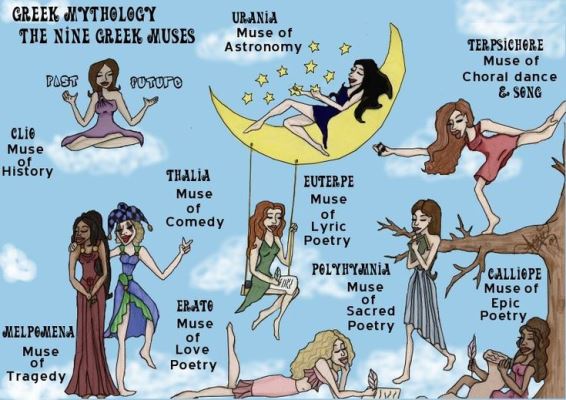Muses: Goddesses of Music, Poetry & Arts

The Muses were the Greek goddesses of poetic inspiration, the adored deities of song, dance, and memory, on whose mercy the creativity, wisdom and insight of all artists and thinkers depended. They may have been originally three in number, but, according to Hesiod and the prevailing tradition he established, most commonly they are depicted as the nine daughters of Zeus and Mnemosyne.
Family and Dwelling Places
Hesiod says that the Muses were daughters of Zeus and the Titaness Mnemosyne, the Goddess of Memory; most authors seem to agree with him. However, two ancient lyric poets, claim otherwise: according to Theognis, their father was indeed Zeus, but their mother was actually Harmonia, while according to Alcman, the Muses were, in fact, daughters of Uranus and Gaea. Some later authors have even tried to reconcile the stories, proposing two different generations of Muses.
Most commonly, it was thought that the Muses were born in Pieria at the foot of Mount Olympus, so they were often called either Olympian or Pierian Muses. However, Mount Helicon in Boeotia was a place they certainly held dear to their hearts, since it was here that Hesiod met them and was inspired by them to write “The Theogony.” Unsurprisingly, they are referred to as “Heliconian Muses” in the first verse of that glorious poem.
Number, Names, Attributes, and Domains
Depending on the region where they were celebrated, both the names and the number of Muses varied. There are various accounts of five, seven and even eight Muses. However, they are most often either three (probably in earlier reports) or nine (following Hesiod and maybe Homer).
The Nine Muses
In “The Theogony,” Hesiod tells us that there were nine Muses – and most authors, especially since Roman times, abide by his account. The Greek epic poet gives a meaningful name to each of these nine Muses, but we don’t know whether he had intended a different office for all of them. Later poets, however, used the Hesiodic names as a foundation for further differentiation, so they distributed the Muses among diverse realms, attaching to each of them different attributes and powers. Here’s a tentative list:
• Thalia (“The Cheerful One”) was the Muse of Comedy and was often portrayed holding a comic mask or a shepherd’s crook;
• Urania (“The Heavenly One”) was the Muse of Astronomy, and you can often see her holding a globe;
• Melpomene (“She Who Sings”) was the Muse of Tragedy, and she is either holding a tragic mask or some other symbol of tragedy (sword, club, buskins);
• Polyhymnia (“She of the Many Hymns”) was the Muse of Hymns and sacred poetry, often depicted with a pensive look hidden behind a veil;
• Erato (“The Lovely One”) was the Muse of Lyric Poetry; naturally, she’s usually represented with a lyre;
• Calliope (“The One with a Beautiful Voice”) was the Muse of Epic Poetry; Hesiod claims that she was the foremost among the nine, since “she attends on worshipful princes”; Calliope can often be seen holding a writing tablet;
• Clio (“The Celebrator,” “The Proclaimer”) was the Muse of History, and, quite fittingly, she usually holds a scroll;
• Euterpe (“She Who Pleases”), was the Muse of Flute-playing, which is why she is time and again portrayed with an aulos;
• Terpsichore (“The One Delighting in the Dance”), was the Muse of Choral Lyric and Dancing; as expected, she is usually shown dancing and sometimes holding a lyre.